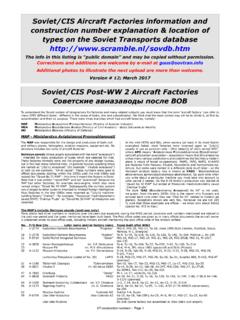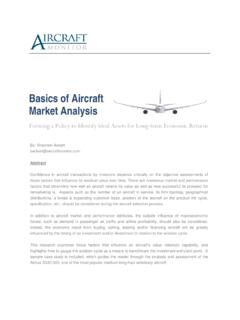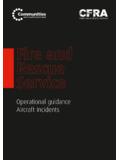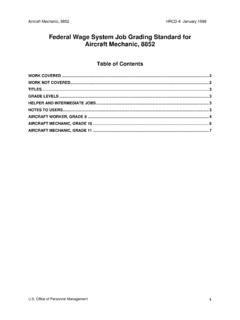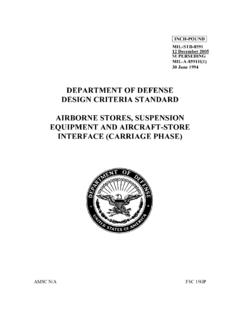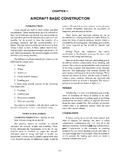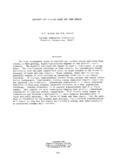Transcription of AIRCRAFT WINDSHIELD AND WINDOW CARE AND …
1 The World s Largest Manufacturer of Light AIRCRAFT Windshields and WindowsAIRCRAFT WINDSHIELD AND WINDOW care AND MAINTENANCEYou can keep your AIRCRAFT WINDSHIELD and windows looking and performing like new by using the proper careproducts and techniques, and by understanding a little about the material you are working , most AIRCRAFT windows are acrylic plastic (as opposed to Lexan or polycarbonate), and acrylic plastic isscratchable. Proper care involves preventing scratches that are preventable and properly taking care of those that are cleaning a WINDOW , always remove as much abrasive dirt as possible without touching the surface.
2 Ideallythis would involve flushing the surface with water and allowing the accumulated bug residue to soak, possibly with a littledish washing liquid added to the water. If a little rubbing is needed, do it lightly with your bare hand. After a final flushingwith more water and carefully drying with a clean soft cloth, use a good grade cleaner/polish intended for acrylic windows ,following the manufacturers need to step back here and take a look at cleaner/polishes. Everybody seems to have a favorite, from great andproper to poor and very dangerous. The good ones, at least those that are safe to use on acrylic plastics, tend to be thecommercial ones, intended to be used on this specific material.
3 The bad ones, including the very dangerous, tend to bematerials never intended to be used as an AIRCRAFT WINDOW cleaner/polish, such as glass cleaners and furniture polish. Glasscleaners invariably contain ammonia, a killer of acrylics. DO NOT use anything containing ammonia on acrylic plastics. Itwill cause crazing (thousands of microscopic cracks) in short order. Furniture polish seems to be safer, but its long term useis undocumented and reports indicate it builds up and produces smears that are hard to polish off. Something to considerabout furniture polish - it is intended to be used indoors, not outdoors, and on furniture, not AIRCRAFT windows .
4 Furthermore,it s not much less expensive than many AIRCRAFT WINDOW and safe care products vary in their ease of use and other properties, so if you don t like what you re using,give another a try. Talk with other pilots about what they are using, but be sure the product you select is intended for acrylicwindows. Other products to keep away from your windows include any aromatic solvent, such as methyl ethyl ketone,acetone, lacquer thinner, gasoline (a minor fuel spill should do no harm), and, heaven forbid, paint stripper. If you have toremove masking tape residue or other sticky or greasy stuff, the safest solvents are 100% mineral spirits or kerosene.
5 Somealcohols are safe, such as isopropyl alcohol, but not the polishing cloth, use the softest cotton cloth available. One hundred percent cotton flannel is idealand available in yard goods stores. Old washed-out cotton T-shirts are a good second choice. We at LP Aero Plastics havenever found a paper product that did not scratch, even those advertised for cleaning plastics. One benefit of cotton cloth isthat it can be washed, thereby effectively recycling the choice of cleaner/polish should also be based on what is needed. Basically, you have to determine what typeof care is needed and pick the best products to do the , it s best to understand what types of products are available.
6 They can be loosely grouped into three catego-ries:1. Non-abrasive liquid sprays, in pumps or aerosols, that may or may not have scratch filling Non-abrasive creams that have scratch filling Mildly-abrasive creams that have scratch removing windows do accumulate minute scratches as part of everyday life (the kind you can t feel with a fingernailbut can really see when flying into the sun), the products that fill fine scratches are great for regular use. If scratches stillappear when flying toward the sun, the abrasive variety and some elbow grease is called for. This type of cleaner should beused occasionally only as needed.
7 Most manufacturers of abrasive cleaners recommend following up with a scratch fillingproduct as a second what happens when you have scratches that you can t take care of with the above methods and perhaps you canfeel with a fingernail? You have to get more aggressive. The danger, though, is in getting too speaking, the only way to remove a scratch from clear acrylic is to remove material from around thescratch down to the greatest depth of the scratch, then polishing the WINDOW back to clarity. There are two problems withthis process. First, polishing back to clarity can be a difficult process especially if you started with a coarser than necessaryabrasive.
8 Second, it is very easy to induce an annoying and possibly dangerous optical distortion if you have not workedevenly in a large enough in mind that some scratches are best left alone because sometimes the cure is worse than the ailment. But ifyou decide to proceed, the morals of the story are to have the patience to work with only the finest abrasive necessary toremove the scratch, and to work in a large enough area to prevent optical distortions. Also, be sure to practice on scrapmaterial before you tackle a WINDSHIELD or 3M Company, Meguiars, Micro-Surface (Micro-Mesh), and others all supply kits that will do this job - withlots of your help.
9 The kits consist of many progressively finer abrasive sheets or creams that are used in sequence toremove defects and to polish back to clarity. Another product, our favorite, is the Satinal pad made by Transelco. This one-time-use pad is dipped in water and makes a 5-micron slurry that will remove fine scratches and polish back to clarity in onestep. For deeper scratches, it can be used in conjunction with 600, 1500, or 2000 grit wet sandpaper. Again, it would bebest to practice on scrap material. By now, you have figured out this can be a lot of work, and you re consideration, especially on light AIRCRAFT , is the feasibility of trying to repair some windows .
10 The wind-shield on the Cessna 150, for instance, is .125 (or 1/8") thick, and some Piper Cherokee rear windows are only .080 (or 5/64") thick. So when you start to remove material, you have to be aware of what you will have left structurally. Keep inmind that most repairable windows , such as those found on pressurized air liners, have published specifications for mini-mum allowable thickness. Most light AIRCRAFT have no such specification. Sometimes, labor spent on a repair attempt wouldprobably be better spent installing a new word of caution. If you are working on a homebuilt with polycarbonate, or Lexan, windows , there is nogood way to remove scratches.

